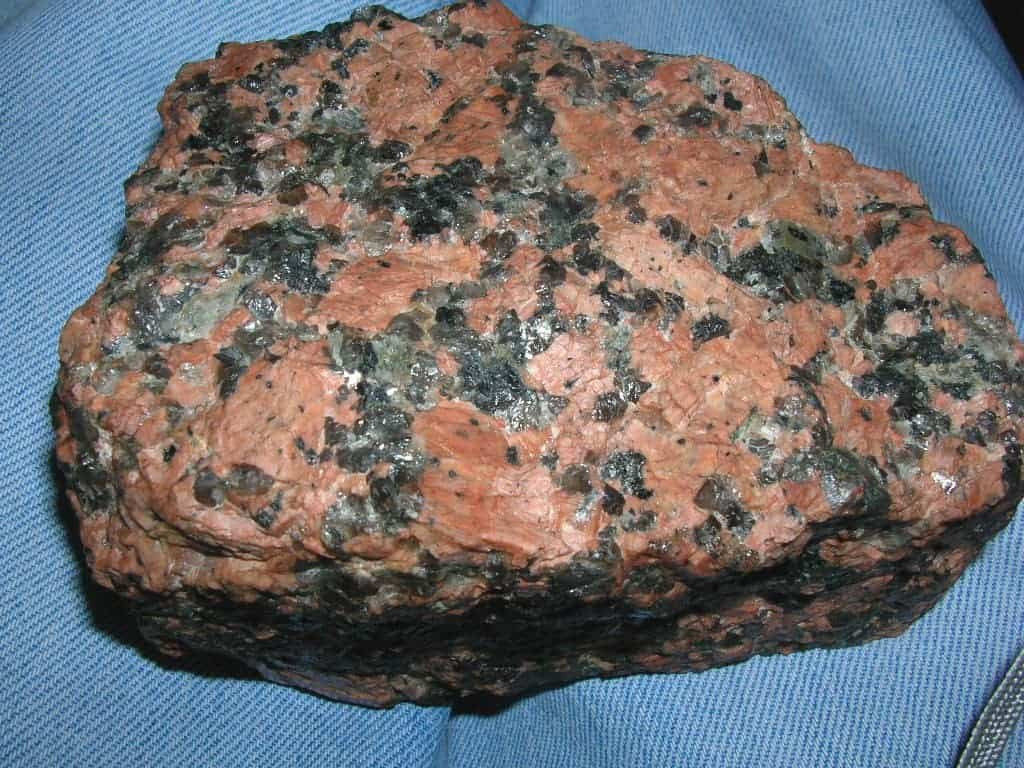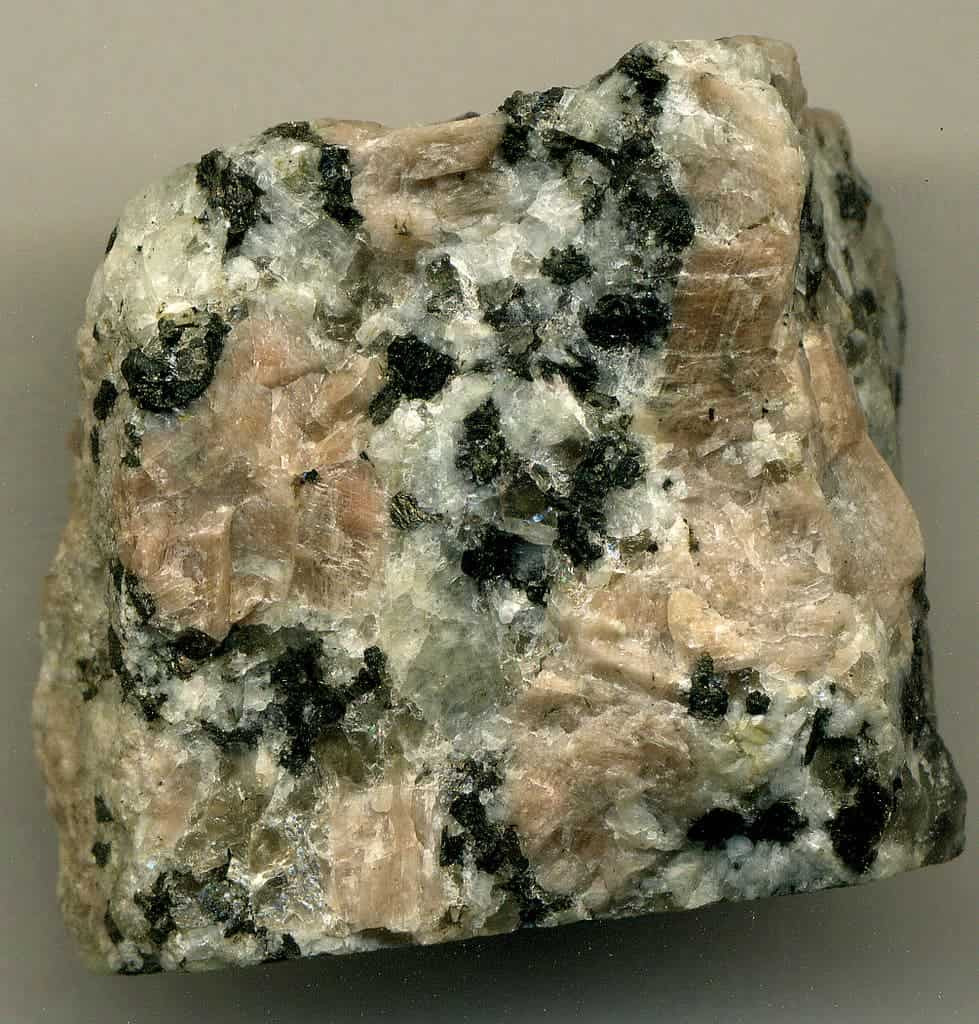Granite identification involves observing its unique characteristics. At rockscapes.net, we provide the insights and resources to confidently identify granite and discover its versatile applications in landscaping. Let’s explore granite’s key features and learn how to distinguish it from other rocks. Discover granite’s composition, formation, and uses, expanding your understanding of this fascinating rock type and other landscaping rocks.
Table of Contents
- How Granites Form
- What Minerals Are In Granite?
- Quartz
- Feldspar
- Amphiboles and Pyroxenes
- Biotite
- What Makes A Granite A Granite?
- Where To Find Granites
- FAQ
1. How Granites Form?
Granites are igneous rocks formed from the slow cooling of magma beneath the Earth’s surface. The gradual cooling process allows for the formation of large, visible crystals, a key characteristic of granite. This process, known as plutonic formation, distinguishes granite from volcanic rocks that cool rapidly on the surface.
Granite’s formation process significantly influences its appearance and mineral composition. Slow cooling allows different minerals to crystallize and grow, creating the granular texture that gives granite its name. The size of the crystals often indicates the cooling rate, with larger crystals suggesting a slower cooling process.
Igneous Rocks
Igneous rocks, like granite, originate from the solidification of molten rock. There are two main types: intrusive and extrusive. Intrusive rocks, such as granite, cool slowly beneath the surface, resulting in large crystals. Extrusive rocks, like basalt, cool rapidly on the surface, producing fine-grained textures.
Plutonic Formation
Plutonic formation occurs deep within the Earth’s crust. The high pressure and temperature, combined with slow cooling, allow minerals to crystallize without disruption. This process results in the formation of large, well-formed crystals that are characteristic of granite and other plutonic rocks.
Cooling Process
The cooling rate of magma is a critical factor in granite formation. Slow cooling allows minerals to separate and form distinct crystals. According to research from Arizona State University’s School of Earth and Space Exploration, in July 2025, slower cooling leads to larger crystal sizes, enhancing the granular appearance of granite.
2. What Minerals Are In Granite?
Granite contains both felsic and mafic minerals, influencing its color and texture. Felsic minerals, typically light-colored, include quartz and feldspar, while mafic minerals, which are dark-colored, include amphiboles, pyroxenes, and biotite. The combination of these minerals gives granite its distinctive speckled appearance.
Identifying these minerals helps in recognizing granite. The relative abundance of each mineral can vary, resulting in different granite varieties. Understanding the mineral composition is crucial for identifying and appreciating the unique properties of granite.
 Granite with pink-reddish feldspar, black mafic minerals, and grey quartz
Granite with pink-reddish feldspar, black mafic minerals, and grey quartz
Felsic Minerals
Felsic minerals are rich in silicon and aluminum, giving them a light color. Quartz and feldspar are the primary felsic minerals in granite. These minerals contribute to granite’s hardness and resistance to weathering.
Mafic Minerals
Mafic minerals are rich in magnesium and iron, resulting in their dark color. Common mafic minerals in granite include amphiboles, pyroxenes, and biotite. These minerals add to granite’s density and influence its overall color.
Accessory Minerals
Accessory minerals are present in small amounts but can add to granite’s visual appeal. These may include tourmaline, beryl, topaz, zircons, and apatite. While not essential for identifying granite, they enhance its uniqueness and value.
3. Quartz
Quartz is a key component of granite, typically making up at least 20% of its composition. It is a sturdy mineral that appears light-grey and has a glassy, transparent look. Its hardness and resistance to scratching help distinguish it from other minerals.
The presence of quartz is essential for classifying a rock as granite. Its unique properties contribute to granite’s durability and aesthetic appeal. Recognizing quartz is crucial for accurate granite identification.
Identifying Quartz
Quartz crystals often stand out from the surrounding minerals in granite. They have a glassy appearance and are typically light-grey. Unlike some other minerals, quartz cannot be scratched with a fingernail.
Quartz Composition
Quartz is composed of silicon dioxide (SiO2). Its chemical composition contributes to its hardness and resistance to weathering. The purity of quartz affects its transparency and color.
Quartz Properties
Quartz is known for its hardness, chemical inertness, and piezoelectric properties. These properties make it valuable in various applications, from construction to electronics. In granite, quartz provides structural integrity and resistance to abrasion.
4. Feldspar
Feldspar is the most abundant mineral in granite, often giving the rock its white or pinkish appearance. There are two main types of feldspar: alkali feldspar and plagioclase. While distinguishing between them can be challenging, identifying feldspar is crucial for granite recognition.
Feldspar’s presence and abundance are key indicators of granite. Its blocky appearance and glassy luster distinguish it from other minerals. Understanding feldspar’s properties is essential for accurately identifying granite.
Types of Feldspar
Alkali feldspar is rich in potassium and sodium, while plagioclase feldspar is rich in sodium and calcium. The ratio of these elements influences the color and other properties of feldspar. Both types are commonly found in granite.
Identifying Feldspar
Feldspar crystals typically appear blocky and have a glassy luster. They break along flat surfaces, a property known as cleavage, which distinguishes them from quartz. Feldspar is generally white or pinkish in color.
Feldspar in Granite
Feldspar’s abundance in granite contributes to its overall color and texture. The interlocking feldspar crystals provide structural support and resistance to weathering. Its presence is a key indicator for identifying granite.
5. Amphiboles and Pyroxenes
Amphiboles and pyroxenes are dark-colored mafic minerals found in granite. They often appear as black prisms and contribute to granite’s overall density and color. While distinguishing between them can be challenging for non-specialists, their presence is a common feature of granite.
The presence of amphiboles and pyroxenes adds to granite’s complexity. Their dark color contrasts with the light-colored felsic minerals, creating the speckled appearance characteristic of granite. Recognizing these minerals helps in confirming granite’s identity.
Identifying Amphiboles
Amphiboles generally appear as long, slender black prisms. They contain water in their chemical structure, which distinguishes them from pyroxenes. Identifying amphiboles requires careful observation of their crystal shape and association with other minerals.
Identifying Pyroxenes
Pyroxenes also appear as black prisms but are typically shorter and stubbier than amphiboles. They lack water in their chemical structure. Distinguishing pyroxenes from amphiboles often requires specialized equipment and expertise.
Role in Granite
Amphiboles and pyroxenes contribute to granite’s density and influence its overall color. Their presence adds to the rock’s complexity and visual appeal. Recognizing these minerals helps in confirming granite’s identity.
6. Biotite
Biotite is a black mica mineral found in granite. It has a sheet-like structure and can be easily scratched with a fingernail. Biotite’s presence is a common feature of granite and can help in its identification.
Distinguishing biotite from other black minerals is essential for accurate granite identification. Its planar sheets and softness set it apart from amphiboles and pyroxenes. Recognizing biotite helps in appreciating the unique properties of granite.
Identifying Biotite
Biotite appears as thin, planar sheets that often split at the edges. It is easily scratched with a fingernail due to its softness. Its black color and sheet-like structure distinguish it from other dark minerals.
Biotite Composition
Biotite is a complex silicate mineral containing iron, magnesium, aluminum, silicon, and water. Its chemical composition contributes to its softness and sheet-like structure. The presence of iron gives it a black color.
Biotite in Granite
Biotite contributes to granite’s overall appearance and texture. Its planar sheets can add a shimmering effect to the rock’s surface. Recognizing biotite helps in confirming granite’s identity.
7. What Makes A Granite A Granite?
Granite is defined by its granular texture and mineral composition. The key is to look for a phaneritic texture, meaning you can see individual crystals with the naked eye. Granite must contain at least 20% quartz, along with feldspar and mafic minerals.
The combination of these features distinguishes granite from other rocks. Understanding the defining characteristics is essential for accurate identification. Exploring granite’s texture, mineral content, and formation process allows for a comprehensive appreciation of this common rock.
 Granite with large crystals, showing quartz and feldspar
Granite with large crystals, showing quartz and feldspar
Granular Texture
Granite’s granular texture results from the slow cooling of magma, allowing large crystals to form. The interlocking crystals create a strong, durable rock. The presence of visible crystals is a key indicator of granite.
Mineral Composition
Granite’s mineral composition includes quartz, feldspar, and mafic minerals. The relative abundance of each mineral can vary, resulting in different granite varieties. The presence of at least 20% quartz is a defining characteristic.
Distinguishing Features
Granite is distinguished by its granular texture, mineral composition, and formation process. The combination of these features sets it apart from other rocks. Recognizing these characteristics allows for accurate identification.
8. Where To Find Granites?
Granites are found across the continental crust, often in mountainous regions. They typically occur as stock masses and are not associated with volcanic eruptions. Local geology museums and national survey organizations like the USGS or BGS can provide specific locations.
Exploring local geology can lead to granite discoveries. Remember that granite can vary in crystal size and weathering, so not all samples will look the same. Checking rockscapes.net is a great place to start your search for inspiration.
Geological Distribution
Granite is widely distributed across the continental crust, particularly in regions with a history of tectonic activity. Mountain ranges often contain granite formations due to the uplift and erosion of deep-seated rocks. Understanding the geological history of an area can help in locating granite deposits.
Local Resources
Local geology museums and national survey organizations like the USGS (United States Geological Survey) or BGS (British Geological Survey) are valuable resources for finding granite. These organizations provide maps, reports, and other information on the distribution of rocks and minerals in specific areas.
Exploring Local Geology
Exploring local geology can be a rewarding way to find granite. Look for outcrops of coarse-grained igneous rock with visible crystals of quartz, feldspar, and mafic minerals. Remember that granite can vary in appearance due to differences in mineral composition and weathering.
9. FAQ
Q: How can I tell if a rock is granite?
A: Look for visible crystals of quartz, feldspar, and mafic minerals. Granite has a granular texture and contains at least 20% quartz.
Q: What are the main minerals in granite?
A: The main minerals are quartz, feldspar (both alkali and plagioclase), amphiboles, pyroxenes, and biotite.
Q: Where is granite typically found?
A: Granite is found across the continental crust, often in mountainous regions and areas with a history of tectonic activity.
Q: What is the difference between felsic and mafic minerals?
A: Felsic minerals are light-colored and rich in silicon and aluminum, while mafic minerals are dark-colored and rich in magnesium and iron.
Q: How does granite form?
A: Granite forms from the slow cooling of magma beneath the Earth’s surface, allowing for the formation of large crystals.
Q: What is the significance of quartz in granite?
A: Quartz is a key component of granite, making up at least 20% of its composition and contributing to its hardness and resistance to weathering.
Q: Can granite be scratched with a fingernail?
A: No, granite is a hard rock and cannot be scratched with a fingernail, though some of its constituent minerals like biotite can be.
Q: What are some common uses of granite?
A: Granite is used in construction, landscaping, countertops, and monuments due to its durability and aesthetic appeal.
Q: How does the cooling rate affect granite formation?
A: Slow cooling allows for the formation of large, visible crystals, which are characteristic of granite.
Q: What should I do if I find a rock that I think might be granite?
A: Compare the rock to descriptions and images of granite, look for its key characteristics, and consult with a local geology expert or museum if needed.
Ready to explore the beauty and versatility of granite in your landscaping projects? Visit rockscapes.net for inspiration, detailed information on various rock types, and expert advice on transforming your outdoor spaces. Contact us at Address: 1151 S Forest Ave, Tempe, AZ 85281, United States, Phone: +1 (480) 965-9011, or visit our Website: rockscapes.net to discover how you can bring the enduring elegance of granite to your home.
